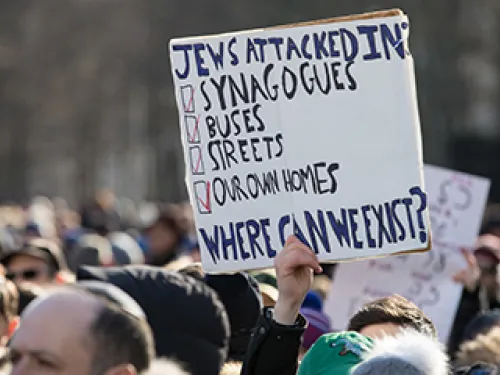Related Content
Widespread Palestinian violence erupted on Friday, September 29, 2000 in the Old City of Jerusalem and in the West Bank and Gaza Strip. The grassroots protests and violence soon turned to a campaign of deadly terrorism targeting Israeli civilians on buses, restaurants and on city streets. Over 1,000 Israelis were killed, and thousands severely injured in these attacks.
Palestinians claimed the outbreak of violence was provoked by the visit of then-Likud Party Chairman Ariel Sharon to the Temple Mount the previous day. Israeli leaders maintain that the violence was orchestrated by the Palestinian leadership, and point to other incidents of violence against Israeli targets in the Gaza Strip days before the Sharon visit. Well before the Sharon visit there were incendiary calls for action in the Palestinian media and in sermons by religious leaders. Furthermore, on September 29, the PA closed the schools under its jurisdiction and coordinated the busing of demonstrators to the Temple Mount. Palestinian leaders have been quoted boasting that the violence was planned as early as July 2000.
The outbreak of Palestinian violence and terrorism was particularly disheartening for Israelis, especially those who were supportive of negotiations with the Palestinians, because it erupted just as the most serious negotiations for a final status agreement between Israel and the Palestinians were being pursued. At the Camp David Summit convened by U.S. President Bill Clinton in July 2000, Israeli Prime Minister Ehud Barak had offered the Palestinians far greater concessions on Jerusalem, settlements, and territory than ever anticipated. Yet, the Palestinians refused the Israeli offer and turned to a campaign of violence.
In the initial weeks of the Second Intifada, there was a popular element to the violence, with large demonstrations in some Palestinian cities. Intermingled with the civilians at these demonstrations were armed Palestinian gunmen, who often used the cover of the crowd to shoot at Israeli installations. During this period, a Palestinian mob in Ramallah attacked two off-duty Israeli reservists, lynched them, and celebrated their deaths. Within a short time, grassroots participation in the violence ebbed, and the Palestinians turned to directly attacking Israeli civilian centers, military installations, vehicles, and civilians through suicide bombings, drive-by shootings, and rocket launchings, which killed over 1,000 Israelis, and left thousands severely injured.
The Palestinian Authority was deeply involved in the violence against Israel through PA-affiliated militia groups such as Fatah’s Tanzim and the Al-Aqsa Martyrs Brigade. The PA leadership, including Yasir Arafat, were directly linked to numerous arms shipments that were intercepted by Israel en route to the Gaza coast, most notably a large cache found in January 2002 aboard the Karine A ship which was on its way from Iran to the Palestinian Authority.
Israel attempted to counter Palestinian violence in a variety of ways. Most directly, it engaged in military operations in the West Bank and Gaza Strip to destroy the terrorist infrastructure. A major incursion was launched in March-April 2002, following the March 22 Hamas suicide bombing of a Passover seder at a Netanya hotel in which 30 were killed and 140 were wounded. As a proactive measure, in 2003, the Government of Israel approved the building of a security fence or barrier, intended to prevent Palestinian terrorists from reaching their civilian targets inside Israel.
Numerous international efforts were undertaken to end the crisis, including plans presented by a commission headed by former Senator George Mitchell (known as the Mitchell Plan, calling for an end to violence, Israeli confidence-building measures, followed by final status negotiations) as well as a timetable set out by CIA chief George Tenet (known as the Tenet Plan, calling for an end to Palestinian violence and terror, Israeli confidence building measures, followed by negotiations for a final status agreement). In September 2002, the United States, the European Union, the Russian Federation, and the United Nations (collectively dubbed The Quartet) announced its sponsorship of “A Performance-Based Roadmap to a Permanent Two-State Solution to the Israeli-Palestinian Conflict.”
The Second Intifada petered out slowly, due in part to Palestinian malaise as well as the effectiveness of Israeli military defense and the protective security fence which served to stymie many terrorist attempts.









